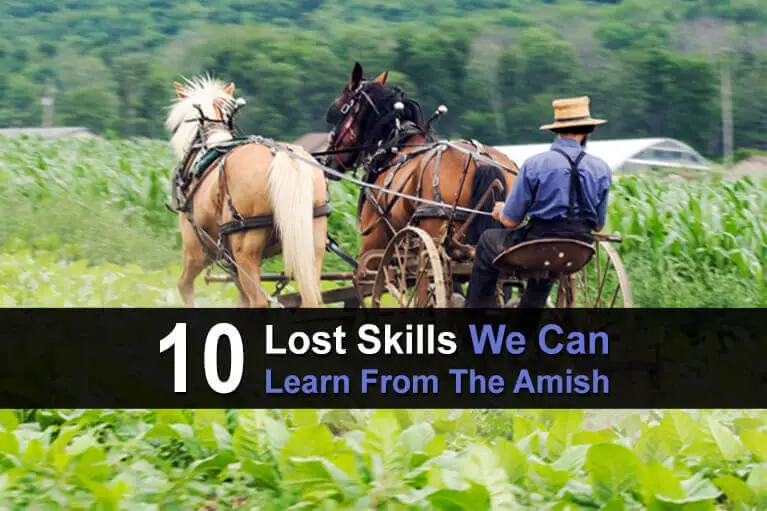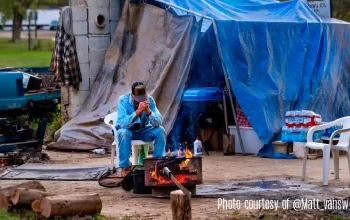Estimated reading time: 14 minutes
The Amish (about 300,000 of them) quietly live among us throughout the United States. They do not live on the grid, not in a conventional manner of speaking, at least.
American Amish communities function from a power grid far superior to our antiquated electrical system – “God’s Grid.” We preppers can learn a whole lot from the Amish and their off-grid way of life…and should before it’s too late.
Before we delve into the individual survival secrets we can learn from the Amish, we need to discuss the foundation of their successful communities. If you merely enhance your skillset and mimic the Amish lifestyle during an SHTF disaster, you are doing both yourself and your loved ones a vast disservice – one that could lead to an epic failure.
Want to save this post for later? Click Here to Pin It On Pinterest!
The Amish live simply and in a manner that is wholly devoted to both their strict faith and to their families. Their deeply held beliefs guide their daily lives explicitly. The bond between family members is always present and absolute.
Prepping families who are still embroiled in a typically overly-scheduled life—both parents spending at least 40 hours a week outside of the home then rushing to meetings, ball practices, music lessons, etc. and rarely ever gathering around the table to share a meal—cannot realistically develop the deep bonds and total devotion to family necessary to survive a long-term disaster.

Amish children are not rapidly ushered out the door to go to a babysitter or government school. They spend their time helping on the homestead and are assigned farm and household chores from a very young age.
Toddlers toting and helping stack firewood is a common sight in the Amish community in my rural county. Amish children are educated at home or in a community school with a curriculum based on practical skills and faith.
Everyone has to learn their jobs and do their fair share of work to keep the Amish farm and/or business humming. Their very lives depend on each family member being able to complete tasks properly, in a timely manner, and unsupervised in order to put food on the table and run a business (usually a home-based one) so the family can earn the money they need to expand their operations.
The extended family often lives together on a single Amish farm or in separate homes on adjoining properties. The Amish have not likely heard the term “mutual assistance group” but they function in this manner constantly and not just during weekend training in preparation for a disaster.
About six years ago, a tri-state region encompassing where we live lost electricity during a powerful summer storm. We were also experiencing a heat wave—a 103°F in the shade kind of heat wave—at the time. Our Amish community members went on with life as normal completely undeterred by the outage.
After several days, word eventually spread into the Amish community about the power outage caused by the storm. They got into their buggies and drove their horses into the sole grocery store in the county to buy up all of the perishables which would soon go to waste when the store’s generators ran out of fuel. Their ice houses were stocked with bargain meat and other perishable food items for the rest of the year.
The storm did so much damage to the store’s electrical system that it reopened only briefly before shuttering its doors for good. We became a food desert for four years until a far smaller supermarket was finally built.
The Amish are a plain people, completely devoid of vanity and materialism. They are so very much like our ancestors who settled this great land. Their clothing is simple, functional, and durable. Their bodies are healthy and strong, and they are not afraid of hard work and find doing it quite fulfilling.
Amish homes are uncluttered. Rarely will you find a closet inside an Amish home, as they do not believe in stockpiling excessive amounts of anything but food and tools. The children have homemade toys and books to read, but not excessive amounts of junk that rarely gets played with or is made of cheap foreign plastic that breaks quickly.
Going inside an Amish home generally has a calming effect. It is neat, it exudes warmth, and it smells delicious thanks to whatever homemade goodness is baking in the 1800s style oven. The family gathers together and actually talks without the distraction of tech gadgets and television.
They may be separated from the rest of society, but they are not isolated from one another. The Amish truly know one another and spend time together both in play and in work – not interacting via text messaging or Facebook.
Why Is Adopting An Amish Mindset So Important, From A Survival Perspective?
Imagine for just a moment that you have worked in an office sitting behind a desk punching away at a keyboard your entire adult life. At the end of the day, you get into a comfortable car, turn on the air conditioning, and listen to the radio so you don’t have to spend a single moment being bored.
A short time later, you arrive at your air-conditioned home, pull something to eat out of the refrigerator, pop it in the microwave, and sit down in an easy chair to watch television and play with your phone until bedtime.
Suddenly, the SHTF. The world that you and your family have always known disappears in an instant.
The lights go out. The air conditioning goes out. No more television or texting. Food begins to spoil in the refrigerator. There is no way to cook food indoors – keeping the smell of the tasty food from wafting to the noses of those who will soon be starving.
As preppers, you have equipped yourself with the skills, tools, and supplies to survive a sudden TEOTWAWKI event. But even though you have trained your body how to react, you may have neglected, partially or completely, the same intensive level of training for your mind.
Spending a weekend living off the grid and honing the survival skills of the entire family is one thing. But primitive living for 48 hours does not give you a good enough look at how your family will hold up both physically and mentally and remain focused for a long-term disaster.
A sort of culture shock will eventually occur, especially for the children and teenagers in the family. Adapting your lifestyle now by simplifying and decluttering it will help your family adjust to a less tech and scheduled oriented lifestyle.
How will your children react when their video games, televisions, and other electronic gadgets are gone for a long time, perhaps forever? Decrease the amount of withdrawal the family will feel by focusing on connecting with each other, your land, and finding joy in the simple things in life – the things that will always be important, where the light bulb shines when you flick a switch or not.
13 Amish Survival Skills
1. Alternative Power
How much of the modern world an Amish community allows to infiltrate their homes and places of work varies by sect. No Amish home has electricity, yet they still have lights at night, a way to cook and refrigerate food, as well as warm water, in some cases. The use of gas generator power, wood burning stove and furnaces, and solar power provides the energy necessary to create a fully functional manufacturing business.
Hydro-power is also used, depending on the home or business’s proximity to a running creek or river. Instead of merely stockpiling fuel for your generator or buying a solar generator, work towards taking your home entirely off-grid in steps and stages that fit your budget.
2. Fence Building and Mending
Strong fences will not only keep your valuable livestock safe and secure, they will help keep the marauding hordes out. I love tactical fencing, but we live in a rural area more than a half mile from a county road – so prying eyes are not an issue here. But you do not have to create a tactical looking fence around your home. In fact, doing so would attract a lot of unwanted attention.
The Amish build wood fences using simple tools and also string barbed wire, which is quite a chore in itself, to create pastures and to separate areas of their farms. Learn how to make and repair your fencing and keep the supplies on hand to make necessary repairs for the long term.
3. Livestock Illness
Learn how to not only detect but also treat livestock illnesses and injuries yourself. Growing your own apothecary to treat both animals and the family should be at the top of your survival priorities list.
4. Farm “Equipment”
Horses are deemed farm equipment by the Amish and are as essential to their daily life as water. The power grid WILL fail during any type of long-term disaster…eventually. Owning horses, knowing how to treat their ailments, train them, and trim and shoe them, could be substantially beneficial to your family.
Not only will you have a way to get around for security patrol that is faster than going on foot and does not require gasoline, you will have an important item and skills to barter with during the post-SHTF rebuilding stage.
Horses are trained by the Amish pull not just buggies but also low-tech versions of modern farm equipment. I cannot think of any essential piece of farm equipment that is not still manufactured with a horse pulling attachment. Some of the farm equipment used by the Amish also include a small gas-powered generator to run the machinery, such as a hay baler.
5. Horse and Buggy Maintenance
While modern societies depend on vehicles that require gas and maintenance, the Amish depend not just on their horses but also the horse-drawn buggies. Maintaining and repairing these buggies requires a distinct set of skills in woodworking and metalwork, as well as knowledge of horse care and harness repair.
In a post-disaster world where gas is hard to come by and vehicles are nothing more than giant paperweights, knowing how to maintain and operate a horse-drawn buggy could be crucial.
6. Food Preparation and Preservation
Learn how to make and prepare food the way our great grandmothers did by following the Amish example. Cookbooks and off-grid food preparation tools are sold online, in Lehman’s – the slightly expensive but cool store (online and brick-and-mortar location in Ohio) that caters to Amish ways.
7. Hand Sewing or Manual Sewing
Old-fashioned manual sewing machines are still on the market. Clothing will be put to the test during an extensive nationwide disaster. What is currently in your closet will have to last for a very long time. Learn how to mend, darn, and sew your own patterns to keep the family warm in the winter, cool in the summer, and to cover growing children.
I often run into local Amish families at area yard sales snagging sheets, blankets, tablecloths, etc. for next to nothing so they can use the items as fabric to make clothing and other necessary items.
Yard sales are also a great place to find buttons and other notions to stockpile. If you find a shirt you do not like or it is in the wrong size but only costs 50 cents, buy it for the buttons or to use as fabric for a young child.
8. Quilting and Insulation
Quilting isn’t just a craft for the Amish; it’s a must-have skill for creating warm, durable bedding and clothing which they need to get through the winter. Using scraps of fabric, which might otherwise be wasted, the Amish create beautiful, functional quilts that provide great insulation.
This skill could be especially valuable in a long-term grid-down scenario, helping people stay warm in cold weather. Plus, quilting can be a communal activity that strengthens bonds among family members and neighbors, echoing the Amish value of community.
9. Gardening
The Amish, homesteaders, and preppers who live on their survival retreat are already growing and raising at least most of their own groceries. And you should be too, regardless of where you live. Amish make the most of every inch of their property, both inside and out, to start seeds and cultivate crops.
The non-materialistic living style leaves Amish wives free to use folding tables in their living rooms to capture the best light in the house to start their seeds, without worrying what visitors will think about their taste in decor. They also are already picking their first crop, even though snow is still likely to fall a couple of more times before it finally feels like spring.
Use the Amish layering techniques of piling dried manure covered by straw to protect cold weather hardy crops like onions, carrots, potatoes, cauliflower, and broccoli so your growing season can begin in February too!
Using natural pesticides is a far better idea than pouring chemicals all over the food you feed your family. Mix up your own bug, wild rabbit, deer repellent, and fungus killing agents to protect your food sources.
10. Natural Medicine and Herbal Remedies
The Amish place a strong emphasis on self-sufficiency in healthcare using natural remedies, which they prepare from herbs grown in their own gardens. They often rely on generations-old recipes to treat common ailments, from colds to inflammation.
Since the pharmacies might all be closed during a long-term disaster, learning how to create your own medicinal remedies using natural ingredients is a very valuable skill.
11. Carpentry
The Amish are often master carpenters, and they do it all by hand. You will not be able to call a professional to repair your barn roof after a storm or to fix the door on your smokehouse. Learn to use manual tools and make essential repairs yourself and with the help of your family.
12. Mechanical Skills
The Amish never have a need to call a repairman for plumbing or equipment problems. By hand or sometimes with the aid of a gas generator or solar power, they can keep their utilities and mechanical equipment in working order so the family can keep their work and chores on schedule. Amish men are generally competent blacksmiths, hunters, and sometimes gunsmiths, as well.
13. Work Ethic
In addition to adopting the mindset of the Amish, you should also learn to achieve the same top-notch work ethic. The day starts around 5 a.m. on an Amish farm and continues until dark when everyone sits down to enjoy supper together.
How many hours per day does your family work together doing chores? How many hours do you think they can suddenly adapt to working when the stress level is at its highest and when they’re tired and hungry?
Better to find out now and develop a new routine instead of crossing your fingers and hoping they can handle strenuous manual labor like champs after the SHTF.
Typical Amish Seasonal Work Schedule
- April – Oats, Barley, Sorghum, and Corn are planted. Tomato seeds are moved outdoors as soon as the threat from the last frost has passed.
- May – Late harvest corn and the rest of the crops are planted.
- June – The first hay cutting takes place. This is also often calving season, depending on when the cows were bred. Berry picking and preservation also begins in June.
- July – Honey is collected, fruit tree starts are transplanted, more berry picking and hay cutting.
- August – Fall wheat is planted and silos are filled with stores to prepare for the coming winter months.
- September – The bulk of the garden is harvested and preserved.
- October – The late corn and wheat are harvested, cover crops planted, cider and jams are made, and perhaps a third cutting of hay – weather permitting is completed. Hunting and the smoking of meat now kicks into high gear.
Go Visit The Amish
The best way to learn Amish skills and more about their way of life is from the people themselves. Nearly every state has an Amish community of some type. In Pennsylvania and Ohio, massive communities exist, most of which have businesses that highlight their skills. These businesses are open to the public and welcoming of tourists.
Amish Communities In The United States
- Ohio Amish – Wayne, Geoga, Holmes, and Vinton County are all home to Amish communities.
- Pennsylvania Amish – Lancaster County
- Indiana Amish – Elkhart County
- Missouri Amish – Webster County
- Iowa Amish – Kalona-Kalona
- Delaware Amish – Kent County
- Colorado Amish – San Luis Valley Area
- Florida Amish – Sarasota Area
- Illinois Amish – Arthur and Arcola
- Kansas Amish – Garnett, Yoder, Hutchinson, and Young Kansas
- Kentucky Amish – Guthrie and Munfordville/Horse Cave, Guthrie
- Maine Amish – Aroostook County, Smyrna County, and Waldo County
- Maryland Amish – Southern Chesapeake Bay area and St. Mary’s County
- Michigan Amish – 35 Amish communities exist in the state
- Mississippi Amish – Pontotoc County
- Minnesota Amish – Becker County, Clearwater County, Fillmore County, Todd and Polk Counties
- Montana Amish – Lake County, Lincoln County, and Rosebud County
- Nebraska Amish – Antelope County and Pawnee County
- New York Amish – Conewango Valley, Clymer, Heuvelton, Maryville, Mohawk Valley, and Lowville
- North Carolina Amish – Union Grove
- Oklahoma Amish – Clarita County and Mayes County
- South Dakota Amish – Hutchinson County
- Tennessee Amish – Ethridge, Carroll County, and Huntington County
- Texas Amish – Bee County
- Virginia Amish – Charlotte County, Giles County, and Halifax County
- West Virginia Amish – Mason and Summers Counties
- Wisconsin Amish – Green Lake County, Cashton, Monroe County, and Vernon County
If the SHTF tomorrow, would your family be ready? The Amish would.
As you can imagine, the Amish way of life is very similar to how American pioneers lived in the 1800s. Watch the linked video below for more information on survival things our great-grandfathers used to do every single day.
Like this post? Don’t Forget to Pin It On Pinterest!
You May Also Like:




